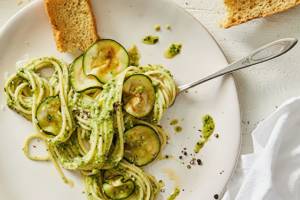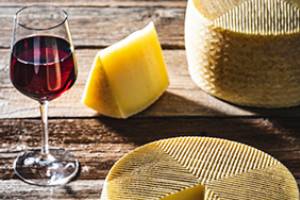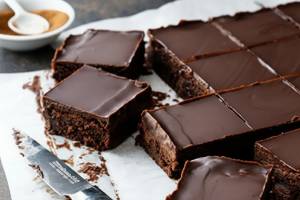
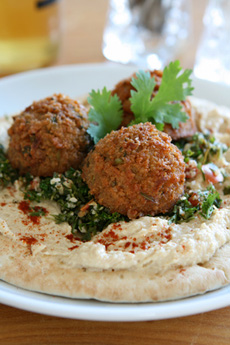 In a falafel sandwich, the falafel (balls of fried mashed chickpeas, shown above) would be inserted into the scored pita bread along with tahini dressing. Here, they are set atop the pita, along with hummus and tabbouleh. Photo © J.Java | Fotolia.
In a falafel sandwich, the falafel (balls of fried mashed chickpeas, shown above) would be inserted into the scored pita bread along with tahini dressing. Here, they are set atop the pita, along with hummus and tabbouleh. Photo © J.Java | Fotolia.
September 2009
Last Updated September 2025
|
 |
Sandwich Glossary
Page 2: Sandwich Types D ~ G
This is Page 2 of a five-page glossary of sandwich types. On this page are sandwich types including falafel, finger sandwich, the French dip sandwich, grilled cheese, and the gyro. Click on the black links below to visit other pages. Also see our Bread Glossary and many other food glossaries.
|
DAGWOOD SANDWICH
A many-layered sandwich named after Dagwood Bumstead, a character in the comic strip “Blondie.” Blondie frequently made exceedingly tall sandwiches for her husband, with numerous layers of cold cuts, cheeses, and condiments. While the “Dagwood” sandwich looked impressive in the comic strip, it isn’t easy to eat one in real life.
|
|
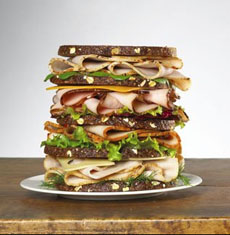
The sky-high Dagwood sandwich. Photo courtesy Boar’s Head. |
DENVER OMELET SANDWICH
A Denver Omelet on toast. The omelet, made with cubed ham, onion, and green pepper, is attributed to Chinese cooks who cooked at logging camps and for railroad gangs in the 19th and early 20th centuries. When it migrated to the modern diner, it became known as a Cowboy or Western sandwich. The sandwich has been updated to include tomato and cheese. See also Kitchen Sink Omelet.
|
|

A Denver Omelet sandwich. Photo courtesy The Spice Kit Recipes: Here’s the recipe.
|
|
DONER KEBAB
Literally, “rotating roast,” döner kebab is a Turkish sandwich made of lamb cooked on a vertical spit, sliced off to order, and generally placed in pita, although other bread, such as an oblong roll, can be used. The dish is similar to what is called shawarma in Arabic and gyro in Greek, although sauces and garnishes differ. In this photo, the sandwich maker carves the spit-roasted lamb into slices prior to inserting it into a pita or a roll, which can be seen at the bottom of the photo at right, and at the large photo below.
|
|
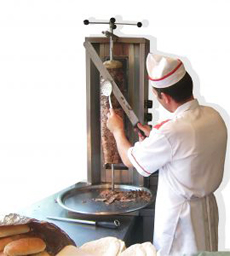
The “rotating roast,” döner kebab. Photo by Arsel Özgürdal | SXC. |
EARL OF SANDWICH
Yes, there was an Earl of Sandwich for whom the sandwich is named. See the history of the sandwich for details.
ELVIS SANDWICH
Elvis Presley’s favorite sandwich was a fried peanut butter sandwich with sliced bananas and bacon. But actually, while known as a fried sandwich, it’s a grilled sandwich because it isn’t dipped in batter prior to frying. Here’s a recipe. We also have recipes for an Elvis Burger and an Elvis Sundae.
|
|
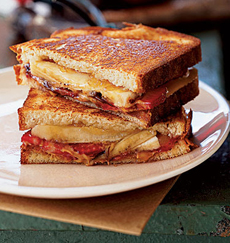
The Elvis Sandwich. Photo courtesy Hipswag.Blogspot.com.
|
FALAFEL
A sandwich of Middle Eastern origin. Falafel is made from chickpeas (or fava beans or a combination of both), seasoned with onion, parsley, and cumin, and deep-fried. In the U.S., falafel is usually served in pita bread with tahini (sesame seed paste) thinned with water or lemon or hummus (chickpeas puréed with tahini). Other accompaniments include tomato, parsley, chopped lettuce, pickled onions, or cucumbers. See the photo at the top of the page. The photo at right, of döner kebab, has a similar presentation in pita but uses sliced lamb and different garnishes instead of fried balls of chickpeas.
|
|

Falafel sandwich. Here’s the recipe (photo © Not Enough Cinnamon).
|
National Falafel Day is celebrated on June 12th.
The history of falafel.
|
FINGER SANDWICH
A finger sandwich is a type of tea sandwich, so named because the rectangular piece of bread was sliced into long “finger” slices, as opposed to the customary triangles or squares. Some people use the term incorrectly to refer to any tea sandwich. However, to be precise, all three sandwiches are tea sandwiches, but only the one at the top, cut into a thin rectangle (a.k.a. finger), is a finger sandwich.
Today, creative cooks prepare pinwheel sandwiches and other shapes to delight those who partake of afternoon tea. All shapes of these delicate sandwiches are also served as party fare.
The history of afternoon tea.
|
|
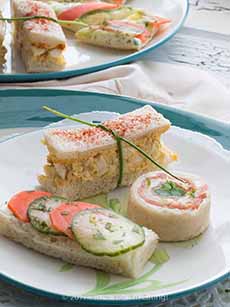
Finger sandwich. Photo © Monkey Business | Fotolia. |
|
FLUFFERNUTTER SANDWICH
A sandwich of peanut butter and Marshmallow Fluff or other marshmallow cream. Marshmallow Fluff, as well as the sandwich, originated in New England. Sometimes bananas and honey are added.
National Fluffernutter Day is celebrated on October 8th.
The history of the Fluffernutter sandwich.
|
|
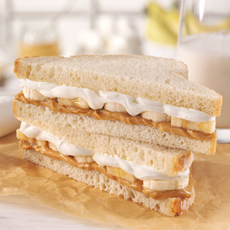
Finger sandwich. Photo © Monkey Business | Fotolia. |
FOCACCIA SANDWICH
A sandwich made with focaccia bread, a thick, seasoned Italian snack bread.
FRIED SANDWICH
A sandwich that is battered and fried. Any sandwich can be fried, but peanut butter sandwiches are a popular choice. See the Elvis Sandwich above.
FRENCH DIP or FRENCH DIPPED SANDWICH
Many credit the creation of the French Dip Sandwich to Philippe Mathieu, a French emigré and owner of Philippe’s sandwich shop in downtown Los Angeles. The year was 1918. The story is that while making a sandwich for a police officer, Philippe accidentally dropped the roll into a pan of hot beef drippings. The officer liked it so much that he came back with friends, asking for the “dipped” sandwich.”
The hot sandwich is made of thinly sliced roast beef served on a French roll or baguette au jus (i.e., with the hot pan juices) for dipping. The sandwich can also be served “wet,” with the meat mixed with the jus before it’s placed on the roll.
The “French” in French Dip most likely referred to the French-style baguette-like roll (and possibly Philippe’s French heritage).
But wait: There’s a second claimant: Cole’s, which insists they created the French Dip 10 years earlier, in 1908. Their story is that chef Jack Garlinghouse made the first one to soften the roll for a customer with sore gums or bad teeth.
There is no evidence to back up either claim. However, we opine, if the customer had problems chewing, why select a chewy filling like roast beef?
Either way, the news spread, and the sandwich became popular nationwide.
Both restaurants opened in the same year, 1908, within a mile of each other in downtown Los Angeles. Both are still serving today.
To keep up with the food scene, today Philippe’s offers not only roast beef, but roast pork, leg of lamb, turkey, pastrami, or ham French Dip. Customers can ask for the sandwich already dipped “single,” “double,” or “triple dip,” or get the jus on the side. All are served on a French roll, which has been dipped in the natural gravy of the particular roast. American, Blue, Cheddar, Monterey Jack, or Swiss cheese may be added. along with coleslaw, macaroni and potato salads, hard-boiled eggs pickled in beet juice and spices, kosher-style sour dill or sweet pickles, black olives, and hot yellow chili peppers. Sounds like a call for a comparative taste test!
|
|
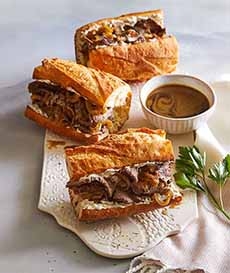
French dip sandwich, with a side of “au jus.” Here’s the recipe (photo © Pampered Chef).

The French dip is often served with a side of fries (photo © Minetta Tavern | Instagram).

At Philippe’s, with popular sides (photo © Philippe The OG | Instagram).
|
FRUIT SANDWICH or FRUIT SANDO
The fruit sandwich likely emerged in Japan at Tokyo fruit parlors, sometime between 1894 and the 1920s. Japan has long had a luxury fruit culture. Fruits were expensive and considered luxury items, given as gifts and generating specialist “fruit parlors,” essentially cafés that specialized in fruit-based dishes as well as fresh fruit sales. The famous high-end fruit seller Sembikiya opened its main shop in 1834 and began operating the first-ever fruit parlor in 1894. It is the most probable originator of the fruit sando. Takano Fruit Parlor in Shinjuku, established in 1926, had fruit sando on its menu when it first opened, suggesting the concept was already established.
The concept likely evolved from Western tea sandwiches, but the Japanese approach transformed it into something unique, with an emphasis on beautiful presentation and seasonal, premium fruits.
|
|
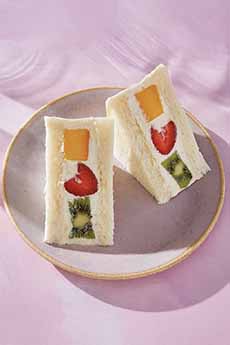
A Japanese-style fruit sandwich (sando). Here’s the recipe (photo by Chris Simpson for The New York Times; food stylist Maggie Ruggiero, prop stylist Sophia Pappas). |
The fruit is layered with whipped cream between slices of soft, crustless white bread (shokupan, a Japanese milk bread). They are then cut to showcase the colorful fruit cross-sections, creating an almost jewel-like appearance. There is even a word for this: mo-eh-dan, meaning “desirable cross section,” where people enjoy the beauty of a cleanly-cut sandwich. Available at coffee shops and food courts, they're often served at parties and when entertaining guests.
In Japan, diagonally-cut sandwiches only became popular in 1961, when the owners of Furenpan bakery decided to cut their sandwiches diagonally, to better show off the sandwich filling and to make it easier for people to eat. They even patented this way of cutting the sandwiches, but relinquished the patent prior to the 1964 Tokyo Olympics so that more people could experience the triangle sandwiches.
Fruit parlors continue to serve as special-occasion destinations for celebrations, dates, and to experience luxury fruits in an affordable format. In addition to sandos, menus include parfaits, shortcakes, and other fruit dishes.
GRILLED CHEESE SANDWICH
A form of fried sandwich that consists of two slices of bread, usually buttered, with cheese melted in between. Considered to be the most popular sandwich in America (discounting the hamburger, which is not considered a sandwich by most people, although it is technically a sandwich and part of this glossary), it is at the top of the comfort food list. Popular additions include tomato and bacon. See our gourmet grilled cheese sandwich recipes.
National Grilled Cheese Sandwich Day is celebrated on April 12th.
|
|
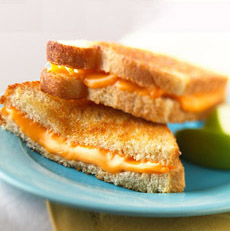
Grilled cheese sandwich. Photo courtesy of Wisconsin Milk Marketing Board. |
The history of the grilled cheese sandwich.
GRILLED SANDWICH
A sandwich that is grilled in butter or oil. Examples include grilled cheese and panini.
|
GYRO
Pronounced YEER-o in Greek, this is the original “hero” sandwich, having nothing to do with the modern hero sandwich on a long “submarine” roll. It includes rotisseried or grilled meat (typically lamb or chicken) with salad ingredients such as tomatoes, peppers, and onions, and a yogurt sauce (tzatziki—yogurt, diced cucumbers, dill, and vinegar); and is often eaten as street food. See döner kebab, above.
National Gyro Day is celebrated on September 1st.
The history of the gyro.
|
|
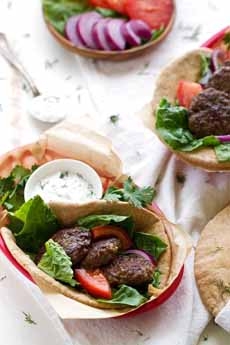
Make a gyro with any type of meat. Here’s the recipe. A gyro is also popular street food, rolled and wrapped in foil for grab-and-go (photo © Little Spice Jar). |
Continue To The Next Page: Sandwich Types H ~ L
Go To The Article Index Above
Lifestyle Direct, Inc. All rights reserved. Photographs are the copyright of their respective owners.

|
